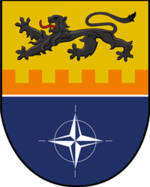| Joint Support and Enabling Command | |
|---|---|
 Coat of arms | |
| Founded | 2018 |
| Allegiance | |
| Type | Joint operational level support command |
| Role | Enablement, reinforcement and sustainment of military forces |
| Size | ≈ 200 personnel |
| Part of | |
| Headquarters | Ulm, Baden-Württemberg, DE |
| Website | jsec |
| Commanders | |
| Commander | Lieutenant General Kai Rohrschneider |
| Deputy Commander | Major General Dariusz Ryczkowski |
| Chief of Staff | MG Antoine Richard Laurijssen |
The Joint Support Enabling Command (abbr.JSEC) is a joint operational level command under the NATO Military Command Structure. The command is designed to facilitate the rapid movement of forces across national borders in Europe. [1] [2] According to NATO spokesperson Oana Lungescu, "The new command in Ulm will help our forces become more mobile and enable rapid reinforcement within the Alliance, ensuring we have the right forces in the right place at the right time". [3] It is under the operational command of Supreme Allied Commander Europe (SACEUR). [4]
Contents
The command is staffed by 160 personnel and extendable to 600 if required. It is located in Ulm, Germany. [3] Another article states it will have around 280 personnel in peacetime and more if a crisis develops. [4] Its first commander was Lieutenant General Jürgen Knappe, also concurrently Commander Multinational Joint Headquarters Ulm. [5] The command was declared initial operational capable on 20 September 2019. [6]
